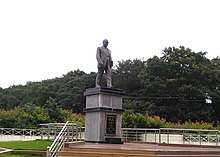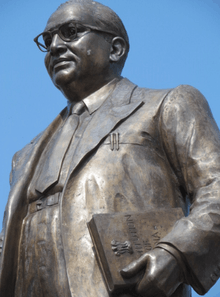Dr. Babasaheb Ambedkar Marathwada University
 | |
| Motto |
हे ज्ञानिची पवित्रता। ज्ञानीचि आथि॥ English: "Knowledge is sacred and is the source of enlightenment" |
|---|---|
| Type | Public/government |
| Established | 1958 |
| Chancellor | C. Vidyasagar Rao |
| Vice-Chancellor | Professor B.A. Chopade |
| Students | Above 4,44,336 |
| Location | Aurangabad, Maharashtra, India 19°54′17.88″N 75°18′43.62″E / 19.9049667°N 75.3121167°E, India |
| Campus | Urban, total 725 acres (2.9339 km2) |
| Affiliations | UGC, NAAC, AIU |
| Website | http://www.bamu.ac.in |
Dr. Babasaheb Ambedkar Marathwada University (BAMU), formerly Marathwada University, is located in Aurangabad, Maharashtra, Republic of India. It is named after Bharat Ratna Dr. "Babasaheb" Ambedkar, an Indian jurist, political leader, academic and the chief architect of the Indian Constitution. This university was established primarily on the initiative of Dr. Babasaheb Ambedkar so as to fill the huge lacuna of higher education facilities in western Vidarbh, Marathwada and North maharashtra region.The university was established on 23 August 1958. This university has contributed to the progress of adjoining regions and people in innumerable ways.Since its inception, the university has around 404 colleges affiliated[1] to it, which come under four districts (Aurangabad, Jalna, Beed and Osmanabad) of Maharashtra State. The student population exceeds 4,44,336.
History



There were nine colleges in Marathwada, listed below, all affiliated with Osmania University at Hyderabad in current Andhra Pradesh state. In response to demand of the public in Marathwada region for a university, the government appointed on 27 April 1957 a committee with the charter to provide recommendations regarding establishment of such a university. The then governor of Bombay state signed the Marathwada University Act on 5 May 1958. Shri Jawaharlal Nehru, the first Prime Minister of India, inaugurated Marathwada University on 23 August 1958 at Aurangabad on the premises of the temporary main building of the university.
S.R. Dongerkery became the first vice-chancellor. Affiliation of the following nine colleges was transferred from Osmania University to the newly formed Marathwada University:
- The Government College of Arts and Science, Aurangabad (established in 1923).
- The Milind Mahavidyalaya, Aurangabad (established in 1950).
- The People's College, Nanded (established in 1950).
- The Government College of Education, Aurangabad (established in 1954).
- The Marathwada College of Agriculture, Parbhani (established in 1956).
- The Manikchand Pahade Law College, Aurangabad (established in 1956).
- The Government Medical College, Aurangabad (established in 1956).
- The Yogeshwari Science College, Mominabad (established in 1956).
- The Arts and S.B.L. Commerce College, Jalna (established in 1958).
Namantar Andolan
In 1978, the Maharashtra Chief Minister, the state legislature and University administration approved the renaming University after B. R. Ambedkar.[2] This decision was strongly opposed by Hindu community[3] resulting in the anti-Dalit pogrom.[4] The Namantar Andolan was the renaming movement raised by Dalits for 16 years. On 14 January 1994 the University name was renamed as "Dr. Babasaheb Ambedkar Marathwada University".[5]
Notable Donations
The Seventh Nizam of Hyderabad, Mir Osman Ali Khan had initially allotted 54 acres of land to Dr. B R Ambedkar for the establishment of the erstwhile Milind Mahavidyalaya.[6][7]
Campus
The university campus covers more than 725 acres (2.93 km2). The hills provide a picturesque background. The Aurangabad caves are embedded in the campus. The Soneri Mahal (Golden Palace), an ancient monument at the foot of the hills, is at the center of the campus, while Bibi Ka Maqbara is at the north side.
Library
Knowledge Resource Centre is the main library of the University. The University library was founded in the year 1958 as the Varsity library. The University library houses some old books dating all the way back to the year 1600. Recently Knowledge Resource Centre subscribed to the World E-book Library through a Noida-based company, which will enable the students to access over 300,000 e-books including journals and other documents.[8][9]
Coat of arms
The university's coat of arms bears the following emblems:
- An Ajanta Arch with the university motto inscribed in its base. The arch is a symbol of the glory of the art of painting and sculpture which reached their acme in the Ajanta Caves.
- An open book lying on a book-rest, symbolizing learning.
- A sheaf of jowar, representing agriculture, the chief means of livelihood of the people of Marathwada.
- Two elephants, representing the strength of purpose of the people of Marathwada.
- A wheel representing progress.
The coat of arms may be regarded as fair representation of the aims and ideals of the university, which has been established among, people mainly devoted of the vocation of agriculture, with a rich cultural back ground and a firm determination to pursue knowledge and learning and at the same time to achieve economic and industrial progress. The motto affirms the inviolability of knowledge; a quality that abides is knowledge itself.
Departments
BAMU has 42 departments:
- Marathi Language and Literature
- English
- Hindi
- Foreign Language
- Economics
- Political Science
- Public Administration
- History and Ancient Indian Culture
- Sociology
- Commerce
- Management Science
- Zoology
- Chemistry
- Botany
- Mathematics
- Statistics
- Physics
- Dramatics
- Cultural Studies
- Communication & Journalism
- Library and Information Science
- Pali and Buddhism
- Psychology
- Physical Education
- Environmental Science
- M.E.(Digital Communication)
- Computer Science and IT
- Education
- Geography
- Sanskrit
- Tourism Administration and Management
- Urdu
- Law
- Atomic Physics
- Biochemistry
- Biomechanics
- Genetics
- University Department of Chemical Technology (UDCT)
- Fine Arts
- Dance
- Marine Science
- Nanotechnology
- Printing Technology
Osmanabad Sub-Center
On 5 August 2004, a subcenter of BAMU was established at Osmanabad. It has been temporarily started at Government Ayurvedic College in Osmanabad.
The subcenter has the following postgraduate departments:
- English
- Education
- Chemistry
- Microbiology
- Biotechnology
- Water and Land Management
- Department of Management Science (MBA & MC)
Student halls of residence
There are separate halls of residence for both boys and girls those who are enrolled at university.[10]
Boys
- Chhatrapati Shivaji Maharaj Boys Hostel No. 1
- Siddharth Sanshodhan Chatra Boys Hostel No. 2
- Karmaveer Bhaurao Patil Boys Hostel No. 3 (Earn and Learn)
- Maharshi Vitthal Ramji Shinde Boys Hostel No. 4
- Boys Rest-House
Girls
- Krantijoyti Savitribai Phule Hostel Girls Hostel No. 1
- Matoshri Jijau Girls Hostel No. 2
- Priyadarshini Ladies Hostel
Notable alumni
- Gangadhar Pantawane
- Sukhadeo Thorat
- Nirupama Rao
- Ravindra Gaikwad
- Madhusudan Manikrao Kendre
- Makarand Anaspure
- Varsha Usgaonkar
- Yogesh Shirsath
- Janardan Waghmare
- Mutinda Mutiso
- Francis Meja
- Benson Momanyi
- Prahba Choksey
- Ananania Mwaboza
- Enock Magara
See also
References
- ↑ University, Website. "Dr.BAMU Affiliated Colleges" (PDF). Archived from the original (PDF) on 14 October 2012.
- ↑ Damle, Y.B. (January–June 1994). "Holocaust in Marathwada" (PDF). ICSSR Research Abstracts Quarterly. Indian Council of Social Science and Research. XXIII. Retrieved 29 October 2013.
- ↑ Atyachar Virodh Samiti (12 May 1979). "The Marathwada Riots: A Report". Economic and Political Weekly. 14 (19): 845–852. JSTOR 4367590. (subscription required)
- ↑ Jaoul, Nicolas (2008). "The 'Righteous Anger' of the Powerless: Investigating Dalit Outrage over Caste Violence". South Asia Multidisciplinary Academic Journal (2). Retrieved 10 May 2013.
- ↑ Shastree, Uttara (1996). Religious Converts in India: Socio-political Study of Neo-Buddhists. Mittal Publications. pp. 100–101. ISBN 9788170996293.
- ↑ "A 'miser' who donated generously". thehindu. May 24, 2013. Retrieved July 7, 2018.
- ↑ "Nizam gave funding for temples, Hindu Educational institutions". siasat. May 24, 2013. Archived from the original
|archive-url=requires|url=(help) on|archive-url=requires|archive-date=(help). Missing or empty|url=(help);|access-date=requires|url=(help) - ↑ "Dr Babasaheb Ambedkar Marathwada University set to open dedicated research e-library tomorrow". TOI. Retrieved 27 October 2013.
- ↑ "University Library". BAM University. Retrieved 27 October 2013.
- ↑ Facilities, Hall of Residence. "Hostels". Archived from the original on 14 October 2012.
External links
| Wikimedia Commons has media related to Dr. Babasaheb Ambedkar Marathwada University. |